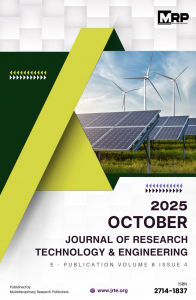Downloads
Nanostructured materials, with structural dimensions of 1–100 nm, exhibit extraordinary properties arising from quantum confinement and high surface-to-volume ratios. This review surveys their fundamental principles, fabrication routes (top-down and bottom-up), property enhancements, cross-disciplinary applications, and prevailing challenges across engineering domains. Metallic nanoparticles, carbon-based nanomaterials, and inorganic/semiconductor nanoparticles are classified by composition and dimensionality, highlighting distinctive functionalities. Fabrication strategies—including lithography, mechanical milling, chemical vapor deposition, atomic layer deposition, sol-gel, hydrothermal synthesis, and self-assembly—are compared for precision, scalability, cost, and suitability. Demonstrated performance gains include mechanical, electrical, thermal, and chemical improvements over bulk counterparts. Application case studies span high-frequency graphene transistors, targeted drug delivery and antimicrobial coatings, nano-reinforced concrete and self-cleaning surfaces, and high-capacity energy storage systems. Key barriers to commercialization include synthesis reproducibility, scale-up, nanotoxicology, long-term stability, and regulatory standardization. Market outlooks project substantial growth toward 2030, driven by nanomedicine, flexible electronics, and sustainable energy. The review concludes that realizing the full potential of nanostructured materials requires interdisciplinary collaboration, robust risk assessment, and harmonized global policies to ensure safety, ethics, and sustainability.
Written by JRTE
ISSN
2714-1837
| M | T | W | T | F | S | S |
|---|---|---|---|---|---|---|
| 1 | 2 | 3 | 4 | 5 | ||
| 6 | 7 | 8 | 9 | 10 | 11 | 12 |
| 13 | 14 | 15 | 16 | 17 | 18 | 19 |
| 20 | 21 | 22 | 23 | 24 | 25 | 26 |
| 27 | 28 | 29 | 30 | 31 | ||
Our Visitors






 Users Today : 12
Users Today : 12 Total Users : 42629
Total Users : 42629 Views Today : 12
Views Today : 12 Total views : 105078
Total views : 105078 Who's Online : 0
Who's Online : 0 Your IP Address : 216.73.216.46
Your IP Address : 216.73.216.46

